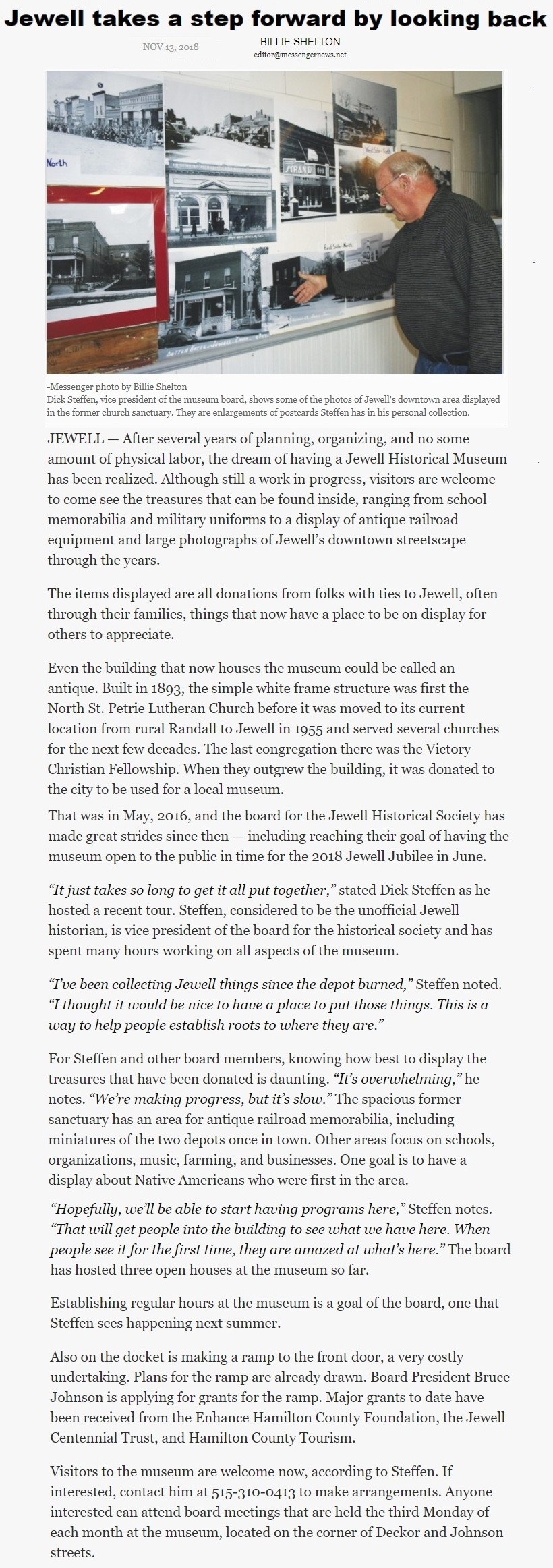Here are some local stories relating to Jewell Junction or to the state of Iowa:
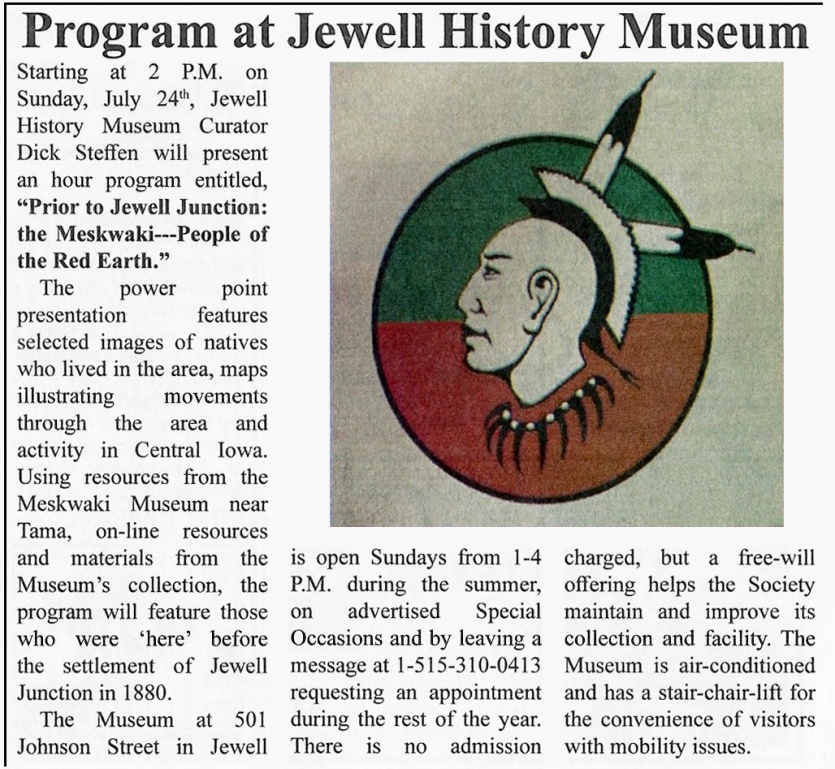 |
|
An audience of fifty watched and listened to Before Jewell Junction: the Meskwaki, People of the Red Earth at the Jewell History Museum Sunday, July 24. Museum Curator, Dick Steffen presented a 45 minute power-point program to relate the ‘Yesterday prior to Jewell’ through the legacy of the Meskwaki up to 2022. The Meskwaki found their way
to the Lake with the Island in the Middle (Goose Lake- east of town) beginning
with the 1880 completion of the Toledo and North Western Railroad line
from Tama to the start of Jewell Junction and through at least 1930.
Tracing the movement of the Meskwaki from the Quebec, Canada area to Kansas
and back to central Iowa, visuals from the Meskwaki Museum and Native American
artifacts on loan in the Museum added to the presentation.
A special thanks to Al Teig and John Hays and family for their loan of
native artifacts currently in the museum through the end of August/Labor
Day.
|
|
and during the first few minutes, you may hear some talking as additional guests enter the Jewell History Museum and find a seat. |
|
|
 |
|
|
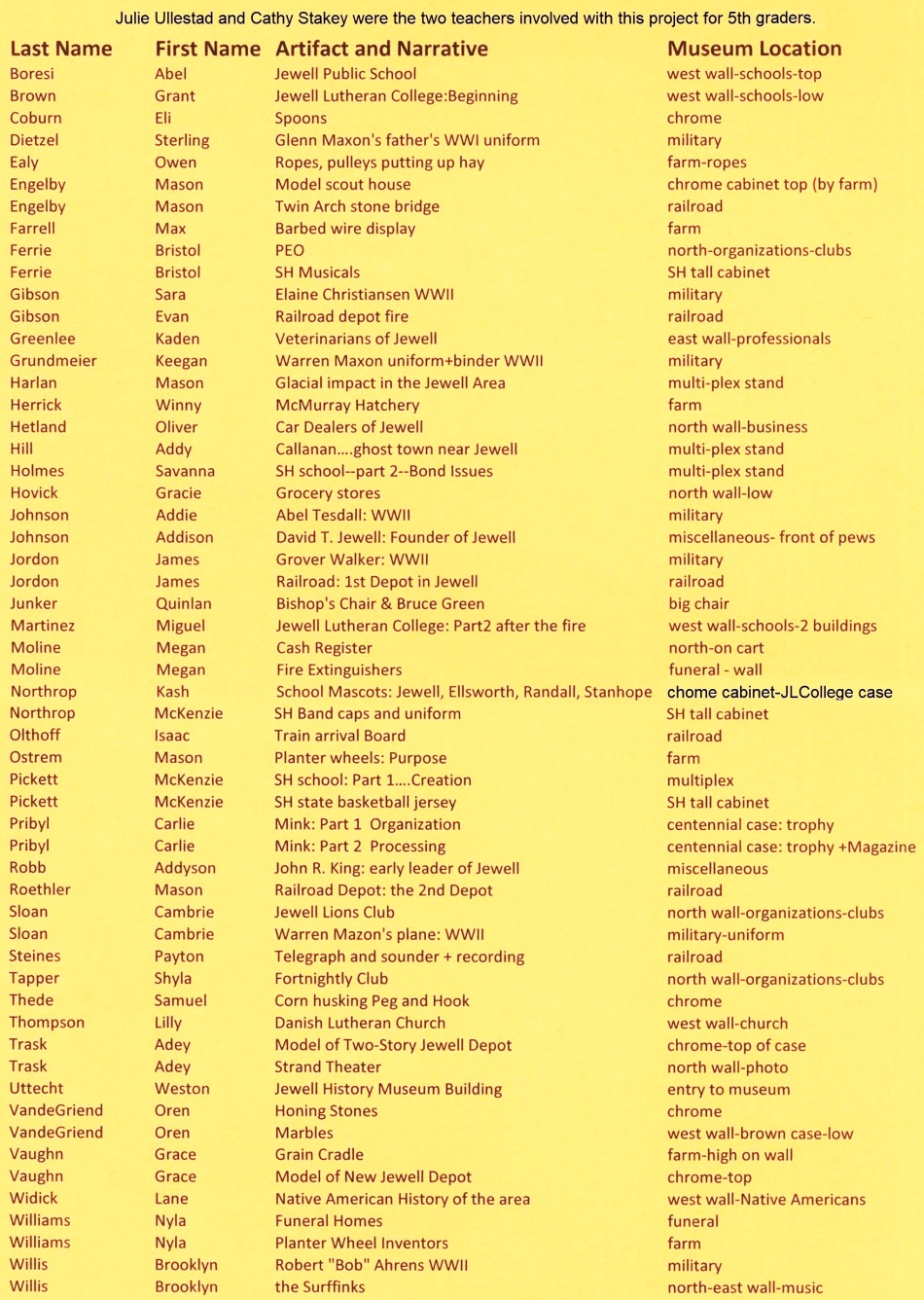 |
|
The History of Pioneer Days in Jewell told by Residents of Those Early Days This letter from Mr. C. H. Kane of Pine City, Minnesota, who lived in Hamilton County the early days: These are the recollections of my boyhood days. I was born and raised on a farm 5 miles from McGregor, Iowa. My stepfather was Conrad Klatbach. He sold out in 1873 and went to Hamilton County, where he bought 240 acres of land. That same year he broke up 60 acres which he put into crop. The next year, in 1874, we moved to our new home about 1¼ miles northeast of where the town of Jewell is now, for there was not town of Jewell then. I was 9 years old when my parents located there. They took out 60 head of cattle with them. The winter of 1874 was terribly cold and stormy and we built a long shed for the stock, but there was so much snow that it drifted clear over the sheds. The snow got so deep that we lost 20 head of fine Hereford cows and for a week I could not go to the barn. We had a wire stretched from the house to the barn and part way between the house and barn we had to tunnel under the snow. We could not get to the Boone River to get coal, so we burned 200 bushels of good corn. Corn was cheaper than coal; it was hard to get 10 cents a bushel for it. The ponds and sloughs were full in those days of muskrats in winter and ducks in the spring and fall of the year. I trapped every winter; have done a lot of trapping on that little stream that flows thru Jewell, the creek that starts from Mud Lake. One day in February I skated up to the lake to do some trapping. I reached the lake and was out in the middle of it when up came a terrible snow storm from the northwest. I had to go with the wind, and on the east side of the lake there was a lot of timber. I made for the thickest timber and you can bet I was frightened. I could not go home because the snow as so thick and the wind blew so hard I could not stand up in it. I went about 20 rods into the thickest timber. By that time it begn to get dark and, finding an old dried tree stump, I took my trapper's hatchet, chopped a hole in the stump, and by good luck managed to get it to burn. I walked around that burning stump all night. The wolves barked all around me during the night, but the fire kept them away, but I was a very happy boy when morning carrived. On my way home I stopped at a neighbor's to get my breakfast, and I got the neighbor to tell my folks that I had stayed at their place all night. Otherwise, my trapping days would have ended right then. I was about 15 years old then. Dave Jewell came from Wisconsin about three years after my parents came; Mr. Jewell and his oldest son boarded at our house until they got their house built. Chester Jewell and I were great chums. We were always together. C. H. Kane
|
|
which was four years after the dedication of Jewell Lutheran College.
Jewell, Iowa April 4, 1898 Ellsworth, Ia. My Dear Sir: It
is my painful duty to report to you Jessie's conduct here so that you may
give him a fathers reprimand and counsel.
His conduct in general was unsatisfactory and several weeks before the close of the term he apologized publicly in chapel for violating the regulations
of the school. But the deplorable climax was reached
just after school closed.
He was discovered one evening in the ladies dormitory in one of the girl's private room together with one girl, the door locked, and the light out. We believe that you desire to be informed of such a serious trespass of right conduct and we also feel it our duty to do so. Regardfully.
Meyer Brandvig.
|
|
|
|
(by Ida Iverson) Painting Schoolgirls Beginning about last fall a dangerous disease broke out among the girls going to our school. A few of the school girls came to school with their cheeks and lips painted and their eye brows darkened. It seemed to be a contagious disease. The person who sat next to one would say, "If she can use rouge and lip stick why can't I?" Fortunately they all did not say that, or the school room would have became a beauty parlor (?) , made up of only paint and eye brow pencils. Even the little girls of the grades caught this disease. Perhaps that is where the style of using all this came from. If someone should ask the victims what was the benefit of all this paint, they would not be able to give a good answer. We suppose some girls put it on to make themselves pretty, but who likes to look at a girl who is all painted up like a movie actress. The girls who are not afflicted with this habit, laugh at their painted schoolmates. We even heard that boys talk about them in doubtful language. We know that many of the parents disapprove of rouge, for some of the girls who use it have to put it on after they come to school and wash their faces before going home. We are waiting for the day when their mothers come to visit school and see them. We can imagine that several would ask to leave the room at the same time to wash it off. There are people who object to too much face powder. But powder, used only to take the shine from the face should not be counted in the same class as rouge. Powder when properly used does not cheapen the appearance of a girl as rouge does. But it is a sign of very little self-respect to put it on your face in the school room, in the halls, or in other public gathering places where others can watch you. As long
as we live with other people, we must watch what other people think of
us. If painting our faces make other people laugh at us, why
do it?
|
|
|
The next two news stories are from 1908.
|
contributions to the history of Iowa 4-H. Here is one: In the early 1920’s the Hamilton County Lamb Club organized a band under the leadership of Mr. John Bonner from Jewell, Iowa. John was the 4-H Lamb Club Leader in Lyon Township. Mr. Bonner recruited the skills of Mr. W. L. Schaub of Blairsburg to serve as the director of the band and George Hanson of the Ellsworth News to serve as manager. Eventually the band expanded to include young people from all over the county. They practiced almost every Sunday afternoon during spring, summer and fall. The band members’ mothers provided supper for the members, if they were to have a concert in a county town on Sunday evening. The 1928 Hamilton County Extension Service Reports indicate that the band was very active. They played at the Iowa State fair, the Hamilton, Boone and Webster County fairs, held two concerts at the American County Life Association meetings in Ames and in numerous concerts at various towns in the county. That year the International Livestock Exposition invited the Hamilton County 4-H Band to be the official band for the show. The band played at the National 4-H Club Congress the first week in December as well as leading the parade for the International Livestock Exposition in Chicago, Illinois. The Hamilton County band was honored to be the official band for several years following this initial performance. Eventually the livestock show officials decided to pass this honor on to another state. But the Hamilton County 4-H Band continued with several in-state engagements. The 1934 Annual Report stated, “It would be very hard to estimate the value of the fine performances of the Hamilton County 4-H Band.” In addition to their appearances in Chicago, they appeared in concerts in Alden, Clarion, Fort Dodge, Blairsburg, Blue Earth, MN, and the All County 4-H Club as well as neighboring county fairs. In 1931 after the band had made three performances at the International Livestock Exposition, the Hamilton County 4-H Club Band approached Dr. Karl King, a well known composer, to write a special march for them to perform in Chicago. He wrote “International Favorites.” This march is on display at the Karl King Music House in Fort Dodge, Iowa, as well as the Hamilton County Extension Office. Owen Crosby, a member of the band, said that in a restroom in Chicago some boys from another state asked them who paid for their trip, and he said they paid their own way, and the boys could hardly believe it – this included buying their own uniforms – part of their expenses were paid by raising money through fundraisers – many of the tickets were sold to “friendly merchants.”
Myron Gere, Geo. A. Hanson, Rex Yockey, John E. Olsen, Arnold Twedt, Vernon Peterson, Clayton Kent, Clair Iverson. Seated - (left to right) - Director W. L. Schaub, Salmer Sather, Alton Berggren, Paul Weaver, Jack Phillips, Joe Henderson, Merdis Miller, Lloyd Okland, Uryth Dillavou, George Sather, Russell Bergeson, Virgil Jones, Carl Teig.  |
|
The men of Jewell, were they to do a little checking up on themselves, would not be able to escape the conclusion that they are pretty good citizens, pretty loyal supporters of their home town. The're a modest lot, the folks here in Jewell, but they can't dodge the charge. The evidence is too conclusive. The bunch sticks by the home town. They come across every time they see a chance to give Jewell a good boost. They give good support to the town ball team. They give loyal support to the churches and schools of the town and are putting them out in front. Jewell business men are putting up the cost of developing and maintaining a splendid town band and they don't mumur about the expense. Municipal improvements are moving along year by year at a rate that is putting Jewell on the map as a real live, enterprising town and Jewell folks are boosters for it. Every time something is to be done to provide a day of entertainment for the patrons of Jewell, the business men of the town came forward gladly and liberally. The recent July Fouth celebration was a good instance of it. Nearly to a man the business men of Jewell and other men as well pulled their coats off, jumped into the harness, gave days of work and contributed liberally of their cash to make it a big day. There were mighty few who could be called "slackers". The Boy Scouts project is up now. There is $1,500 to be raised to buy the land a part of which is to be used for the Scout home and the balance of which is to be held for other public uses in the future. Mark the prediction -- there won't be much trouble in raising the money. Jewell people don't hesitate long when it comes to helping along any good thing for Jewell. That's the story all along the line. Our business men here in Jewell are making a town here; the citizens of this town are responding to every call. There's a moral to all of this. How much is contributed to these things that make for the betterment of Jewell by the business men of Webster City or of Fort Dodge or of Des Moines? How much is contributed by Montgomery Ward or Sears Roebuck? How much is contributed by mail order furniture dealers, or mail order printing concerns, or mail order dealers in lumber and building materials, or mail order dealers in clothing or ladies' cloaks and suits, or any other mail order or out of town concerns? Not one red cent! How much will these vultures contribute towards the Boy Scout building project? Not a penny! How much do these out of town concerns contribute to the support of our town band, or our town ball team, or our chautauqua, or our celebration, or to our schools and churches, or to our municipal improvements? Not a single red copper! The business men of Jewell bear the big burden of the expense of making Jewell a better town in which to live, the business men aided by a few other men who, like them, have a big place in their hearts for anything and everything that boosts for the home town. The people of Jewell profit by what the business men do to make Jewell a better town. They have a better town in which to live, better schools to which to send their children, better churches at which to worship, better surroundings and better opportunities for their families. Their property advances in value as the town is built up. The people in the country surrounding Jewell profit as the business men of the town make Jewell a bigger and better town. They get better markets, they get better trading service, they get a town that offers them more in business, and general community respects. Their farms are worth more by reason of being located near a better town. The business men of Jewell are not alone in the work of building a bigger and better Jewell, but they do a big part of it. And
the business men who give such loyal support to Jewell deserve an equally
loyal support from the people of this community to profit by it.
|
Read a story about one of the first physicians in Hamilton County.
Click to enlarge this news article.
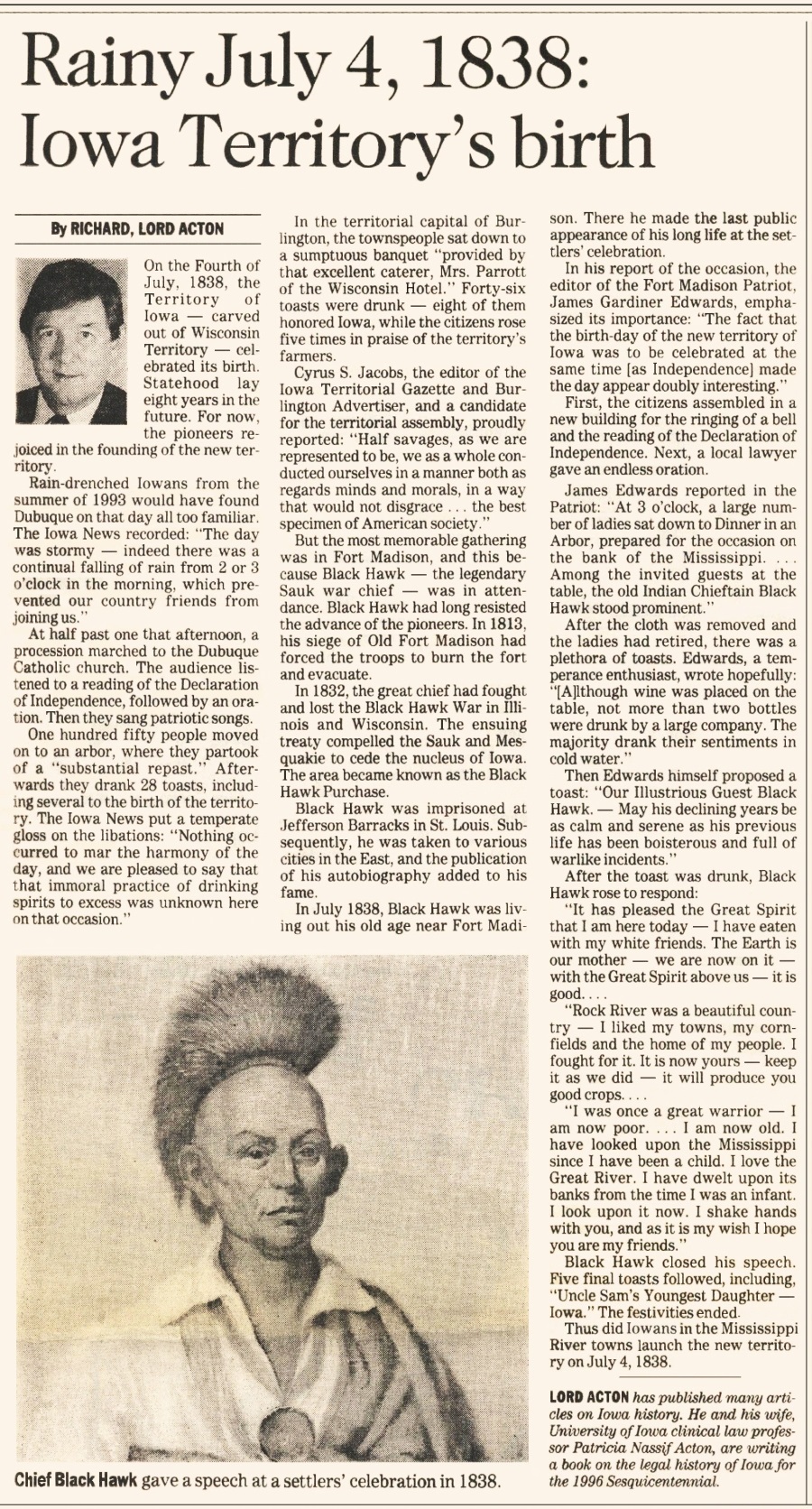
|
Prepared by Martin E. Nass This area was occupied by four different Indian tribes. The Ioway tribe, for whom Albert Lea named our territory, occupied mostly the banks of the Des Moines River to the south. The Sioux tribe was located to the north, the Sac and Fox tribes living in the southern part of our county. The Sioux were very warlike and constantly fought with the Sac and Fox. To effect a peace in the area, the government drew a line that ran to the north of our counties. It was called the "Neutral Line." The Sioux were to stay north of the line, the Sac and Fox to the south. This line was drawn in 1825. In 1830 two more lines were drawn, one 20 miles north of the Neutral line, the other 20 miles south of the line. This area was called the "Neutral Strip." The Indians were paid 3 cents per acre for this land. In 1835 Major Kearney and a company of Dragoons were sent to the area to scout, map, and try to get the Indians to live in peace. As they traveled up the Des Moines River, they took an unnamed fork along a tributary to the east. This was named the Boone River to honor Capt. Nathan Boone, the 10th child of Daniel Boone, and a member of the expedition. Lt. Albert Lea, another member of the party was the first to label and call this area Ioway. We became a state in 1846 and as yet our county lines had not been drawn. Boone County was created as the settlers moved north. In 1850, the legislature decided to create two adjacent counties, just to the north of Boone County. The west county was called Yell, the east county called Risley. Both were named to honor captains of the Mexican War. The two counties had no settlement yet. Only about 12 families lived here. Of note, one family was the Henry Lott family. Lott came upriver in 1847 and built a cabin at what became known as Boone Forks, on the north side of the the junction of the Des Moines and Boone Rivers. He had come from the Red Rock area where he had a history of having problems with the Indians. He came trading firearms, whiskey, and other things with the Indians for furs. He also managed to steal horses and move them down river, keeping them in caves along the banks, to sell to settlers as far south as Missouri. One time, when Henry and his older son were across the Boone River, the Sioux came to his cabin looking for their horses. Mrs. Lott started screaming and when she stopped, Henry decided that she must be dead so he headed south with his son for Pea's Point in Boone County to seek help from his nearest neighbors. After the Sioux party had taken property from the cabin, they left. Mrs. Lott sent her young son, Milton, aged 12, to find his father. Milton ran 22 miles south along the west side of the Des Moines River in December without a coat. He fell exhausted and froze to death. When Lott returned with the rescue party, he found Mrs. Lott delirious in the cabin. She told him to go find Milton. They found his body, but since it was winter they could not bury him so they placed him in a hollow log and covered the opening with rocks, returning in the spring to bury him where he was found. Mrs. Lott lingered until January, 1848 when she too died.
She was the first white woman to die in this area. In 1911 a monument was constructed in Vegors Cemetery, but her body was never located. It is assumed that she was buried beside their cabin. Lott and his older son left the area for several years. They returned in 1852 and tracked down the Sioux chief, Sidominadotah, and moved to be near him. One day they went to the chief and invited him to join them to track a huge herd of elk. After they went some distance from the campsite, Lott hung back and shot the chief in the back. Then he cut off the chief's head and hid the body and head in different places. Then after dark, dressed like Indians, they went to the chief's campsite and slaughtered the chief's mother, wife, and four of his children. One young girl ran away and hid. When the murders were discovered, the Indians went to Major Williams in Fort Dodge for help. Williams declared that Lott had committed the murders. By this time Lott and his son were on their way to California, never to be found again. Sioux Indian Chief Sidominadotah was murdered in 1855 by Henry Lott, which precipitated the Spirit Lake Massacre in 1857. A hearing was held at Homer, conducted by the only lawyer in the area, Granville Burkley. He claimed to understand the Sioux language, but he didn't. No judgment was made, so the Indians left with the body, but Burkley kept the head as evidence. This he hung from a tree in Homer until the wind blew it down. Then Burkley nailed the skull above the door of his cabin, where it stayed for nearly a year. The Indians came back for the skull so it could be buried with the chief. The Indians discussed a retaliation raid on Homer but did not follow through. Sidominadotah had a nephew, a renegade Sioux, named Inkpadutah (sometimes spelled Inkpaduta) who decided to revenge his uncle's death - such act became the Spirit Lake Massacre of 1857. Read what is written in Lee's History of
Hamilton County about this Henry
Lott episode
|
|
Alleged Murderer Captured in Jewell The man whom it is supposed
is the slayer of Frank Beard, the young man recently shot and killed by
tramps at DeWitt, was captured by the city marshal at Jewell Junction Friday
morning. The marshal of couse received the printed description
of the men who were wanted for the terrible murder and had placed it back
in his pocket a day or so ago, but he has a good memory. A
reward of $1,000 is enough to make any man keep his eyes open.
That morning the officer was on his beat between the east end of the town
and the depot. The whistle of the train attracted his attention,
and he wandered to the depot. It was his business to look at
every new comer that reached Jewell Junction, and when he saw a man jump
from a box car he sized him up. "It may be a mistake" he thought,
"but that fellow looks mightily to me like the telegram describes."
He took the little yellow paper out of his pocket again and looked at it.
"By cracky," he said aloud, "That's the fellow." He approached
him and told him to come with him. Jewell was hardly awake
then, but a desperate encounter ensued between the men. Almost
hand to hand they fought. Four times the sharp crack of the
revolver in the hands of the murderer rang out, but each time he missed
his aim, and five times Marshal Lingle answered the shots with his trusted
weapon. The battle between the men raged so fiercely that the
attention of the train men was centered upon them. The engineer
placed his hand to the whistle cord and a steady whistle followed that
brought out half the town. Everyone rushed to the scene.
They saw the predicament the marshal was in and closed in on the murderer.
He was captured and is now in the Jewell jail. His description
that is familiar to every office in Iowa, is that of a man short and heavy
set, dark complexion, wearing a dark brown suit with a light crash hat.
He had on a pair of broad toed shoes.
|
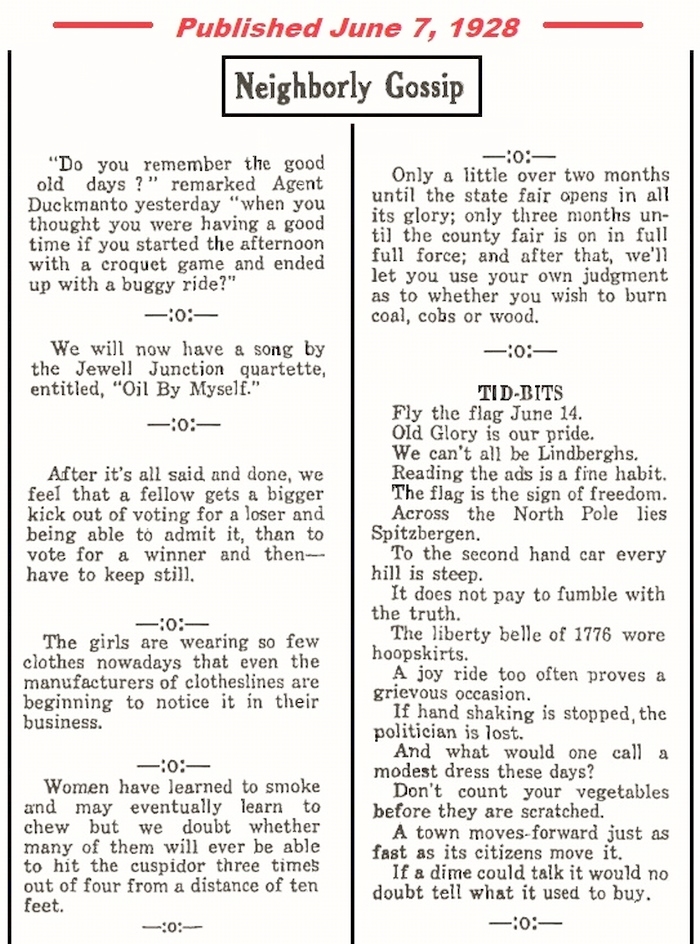
Do you know any interesting stories about Jewell Junction?
Perhaps you should share with us the story of your family.
View Lee's 1912 History of Jewell Junction.
|
The story of Jewell began long ago
We have tried to tell of the first to arrive
To find out who and what and where
So now we hope if at some future date
|
April of 2017
(This news article may be clicked to enlarge for easier
reading.)
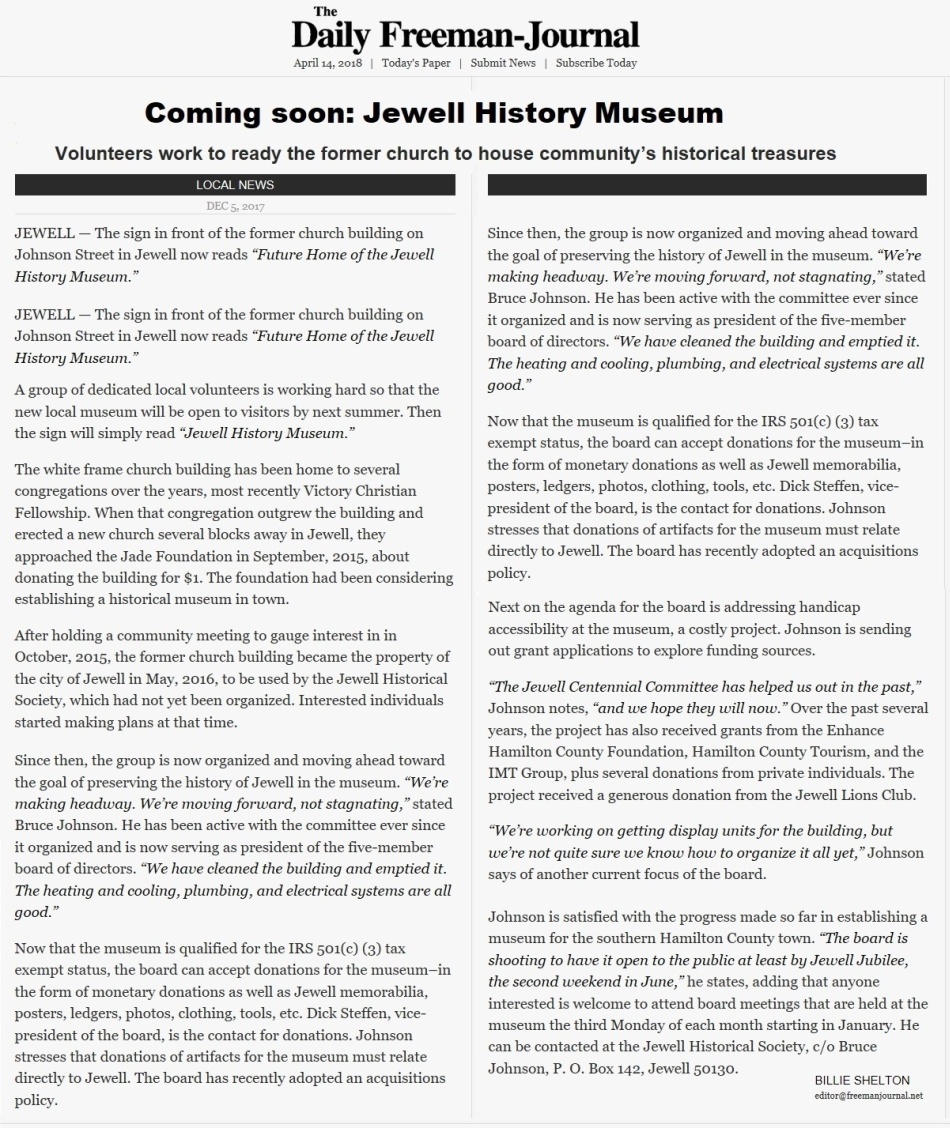
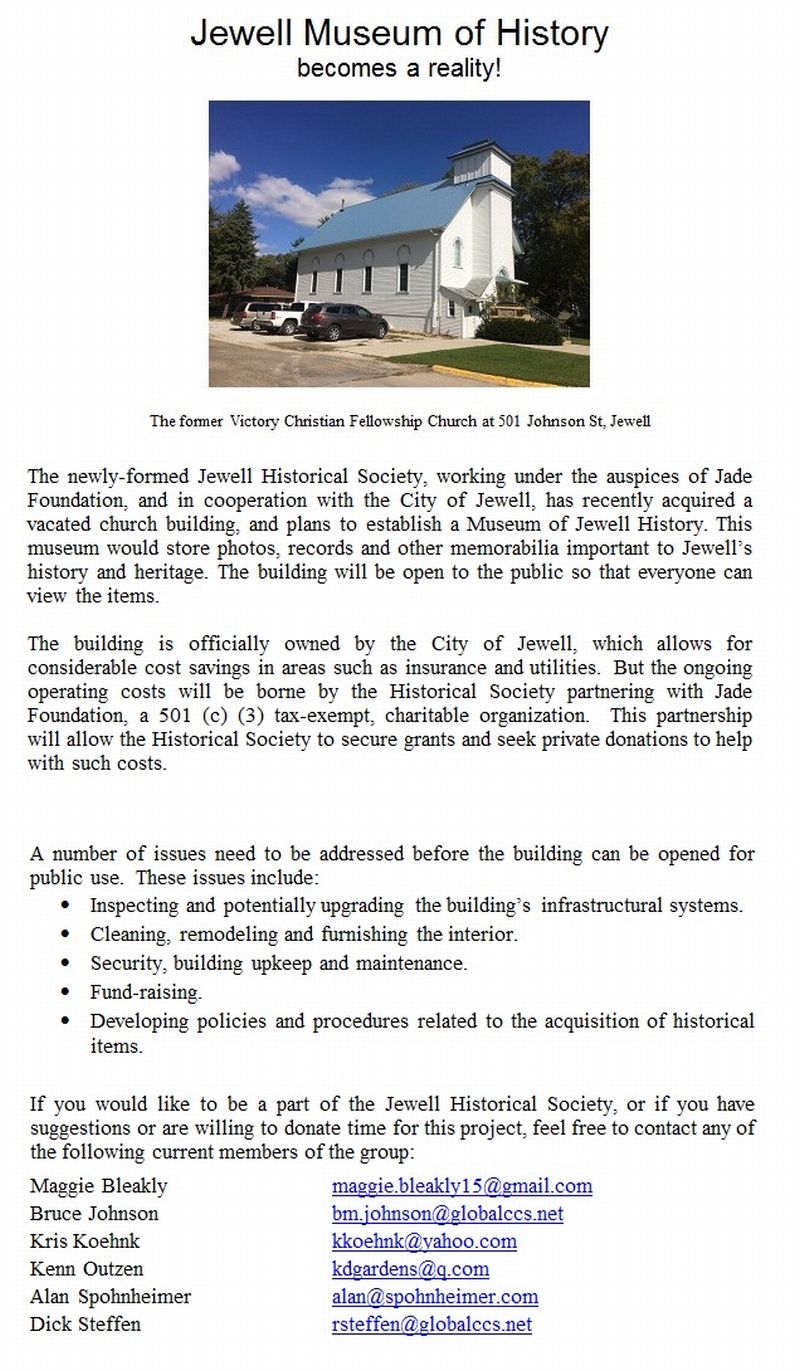
November of 2018
